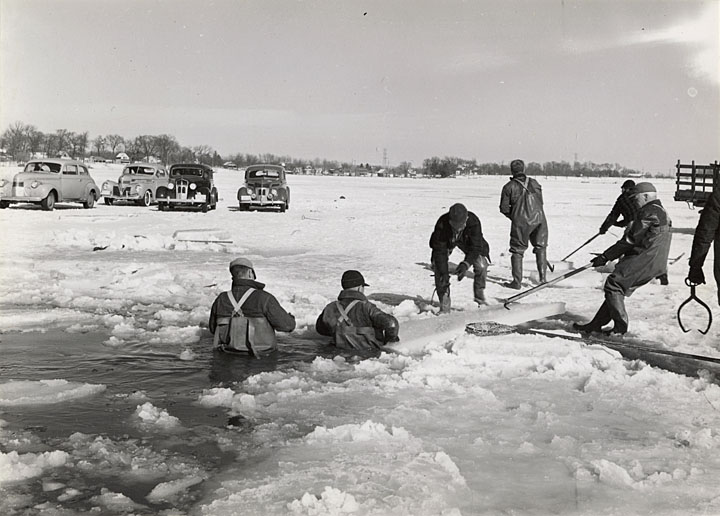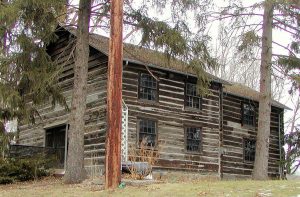The City of Muskego lies approximately twenty miles southwest of Milwaukee in Waukesha County. It occupies almost thirty-six square miles. Originally, Muskego was in Milwaukee County and included modern-day Waukesha, Vernon, New Berlin, and Muskego.[1] In 1839, lawmakers subdivided Muskego into the four self-governing towns.[2] A dispute over 431 acres of land annexed to New Berlin spurred Muskego’s municipal incorporation in 1964.[3]
Muskego’s population size has increased dramatically since 1900. By the 1940s, the number of residents climbed to 2,500.[4] The city’s population has more than doubled since a special census, taken in 1964, which showed that Muskego had 10,497 residents.[5] In 2010 the population was 24,135, of which about 97 percent were white; the rest included African Americans, Native Americans, Asians, and Hispanics.
Three lakes occupy 14 percent of the city’s area. Residents enjoy Big Muskego Lake, Little Muskego Lake, and Lake Denoon as recreational amenities and wetland wildlife habitats. The city’s name is believed to derive from the area’s Potawatomi inhabitants, who named the area Mus-kee-Guacc. The word means “sunfish,” which were abundant in local lakes.[6]
In 1836, Luther Parker built the first house in Muskego.[7] The residents who followed initially sorted themselves by ethnicity. Yankees settled in Muskego Centre, English in Durham Hill to the southwest, Irish in Denoon to the south, Germans in Tess Corners to the northeast, and the Norwegians in Lake Denoon.[8] Norwegians predominated and encouraged more relatives and friends to emigrate.[9] In 1843, this group built the first Norwegian Lutheran church in the United States and published the country’s first Norwegian-American newspaper, Nordlyset.[10]
Muskego’s early economy centered on agriculture. Farmers transported their products to Milwaukee on the Janesville Plank Road; Milwaukee residents traveled the same route to escape city life and enjoy Muskego’s natural attractions.[11] The Milwaukee Electric Railway and Light Company’s trolley line, built in 1904, helped spark the growth of resorts along Lake Muskego. By 1939, automobiles made the trolley line obsolete. Visitors continued to flock to family cottages, local beaches, and the Muskego Beach Amusement Park, which opened in 1925.[12]
By the 1950s, Muskego transformed from a farming community into a suburb.[13] Muskego’s leaders positioned its regional economy in relationship to nearby cities such as Milwaukee, Chicago, Rockford, Beloit, Janesville, and Madison. As the city’s population grew, Muskego’s low taxes attracted businesses and industrial operations.[14] Muskego built several business parks, including the 234-acre Muskego Business Park, which features small- and medium-sized companies, and the company headquarters of InPro Corporation, which manufactures building products.[15]
In 2010, Muskego offered residents 9,431 housing units. 87.3 percent of the city’s population are homeowners. On average, 2.64 people occupy a single family home. As of 2009, the average value of owner-occupied housing units was $269,500.[16]
Footnotes [+]
- ^ Charles Damaske, A Pathway to a City: A Historical Profile of Muskego 1834-1967 (Muskego, WI: Charles H. Damaske, 2014), 6.
- ^ Muskego Historical Society, compilers, Muskego’s History, Where It All Begins Part I (Muskego, WI: Muskego Historical Society, 1980), 2.
- ^ Damaske, A Pathway to A City, 12.
- ^ “Chapter 1: Issues and Opportunities,” The City of Muskego Wisconsin website, accessed May 2, 2015.
- ^ Damaske, A Pathway to A City, 12.
- ^ “Lakes,” The City of Muskego Wisconsin website, accessed April 24, 2015.
- ^ The History of Waukesha County, Wisconsin (Chicago, IL: Western Historical Company, 1880), 766.
- ^ “History,” Muskego Area Chamber of Commerce website, accessed April 24, 2015.
- ^ “History,” Muskego Area Chamber of Commerce website, accessed April 24, 2015.
- ^ “About Nordlyset,” Library of Congress website, accessed April 29, 2015.
- ^ “History,” Muskego Area Chamber of Commerce website, accessed April 24, 2015.
- ^ “History,” Muskego Area Chamber of Commerce website, accessed April 24, 2015.
- ^ Langill and Loerke, From Farmland to Freeways, 167.
- ^ “History,” Muskego Area Chamber of Commerce website, accessed April 24, 2015.
- ^ “Business and Industry,” Muskego Area Chamber of Commerce website, accessed April 29, 2015.
- ^ “Muskego (city), Wisconsin,” United States Census Bureau, http://quickfacts.census.gov/qfd/states/55/5555275.html, accessed April 24, 2015.
For Further Reading
Barton, Albert O. 1937. “Muskego: The Most Historic Norwegian Colony.” Wisconsin Magazine of History 21 (2): 129-38.
Clausen, Clarence A., and Andreas Elviken, trans. and ed. 1951. A Chronicle of Old Muskego, the Diary of Søren Bache, 1839-1847. Northfield, MN: Norwegian-American Historical Association.
Damaske, Charles H. A Pathway to a City: A Historical Profile of Muskego, 1834-1976. Muskego, WI: Charles H. Damaske, 2014.
Langill, Ellen D., and Jean Penn Loerke, ed. From Farmland to Freeways: A History of Waukesha County, Wisconsin. Waukesha, WI: Waukesha County Historical Society, Inc., 1984.
Muskego Historical Society, compilers. Muskego’s History, Where It All Begins Part 1. Muskego, WI: Muskego Historical Society, 1980.
Rönning, Nils N. 1943. The Saga of Old Muskego. Waterford, WI: Old Muskego Memorial.


0 Comments
Please keep your community civil. All comments must follow the Encyclopedia of Milwaukee Community rules and terms of use, and will be moderated prior to posting. Encyclopedia of Milwaukee reserves the right to use the comments we receive, in whole or in part, and to use the commenter's name and location, in any medium. See also the Copyright, Privacy, and Terms & Conditions.
Have a suggestion for a new topic? Please use the Site Contact Form.